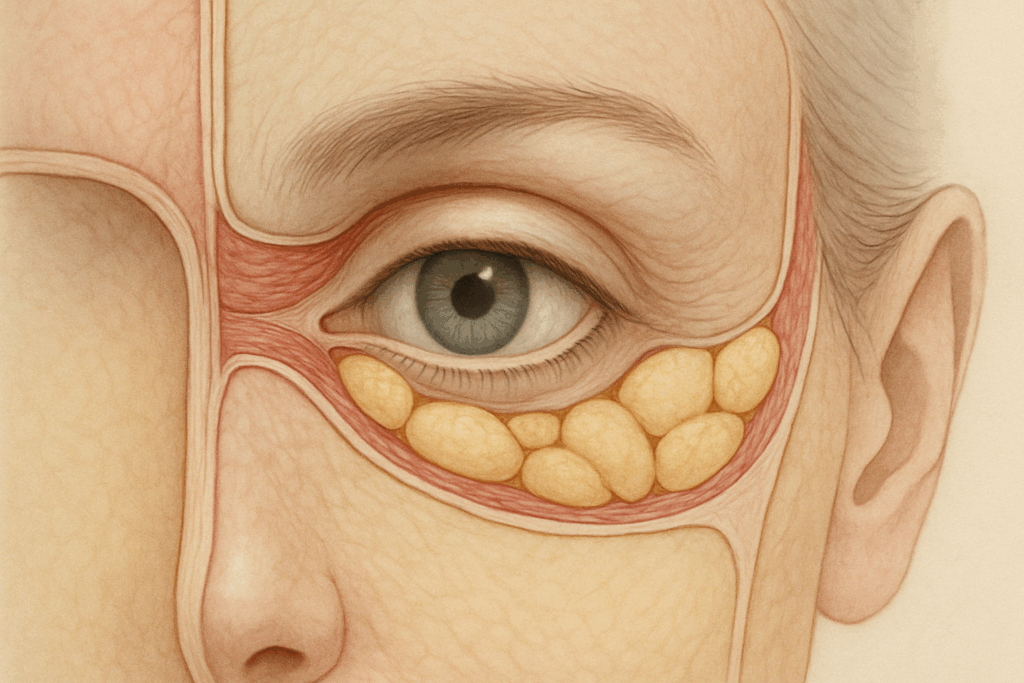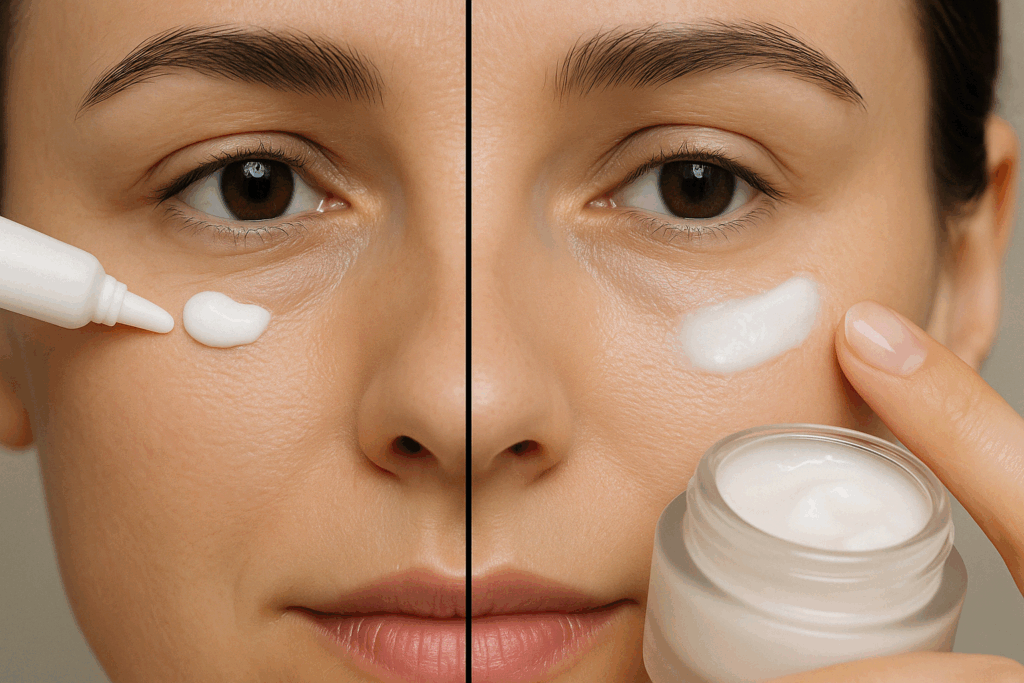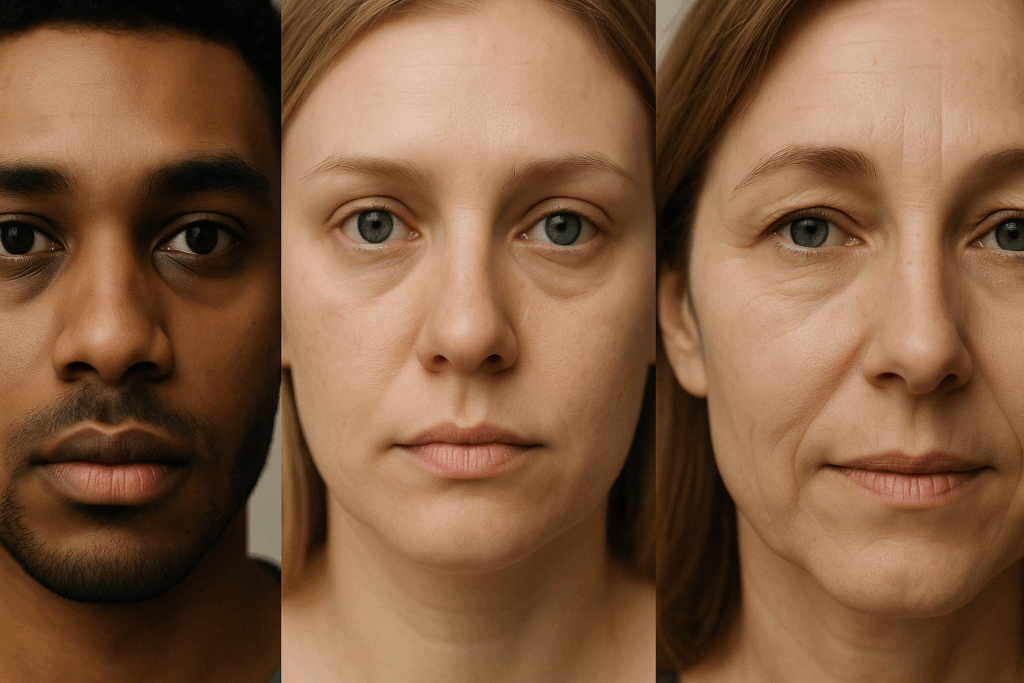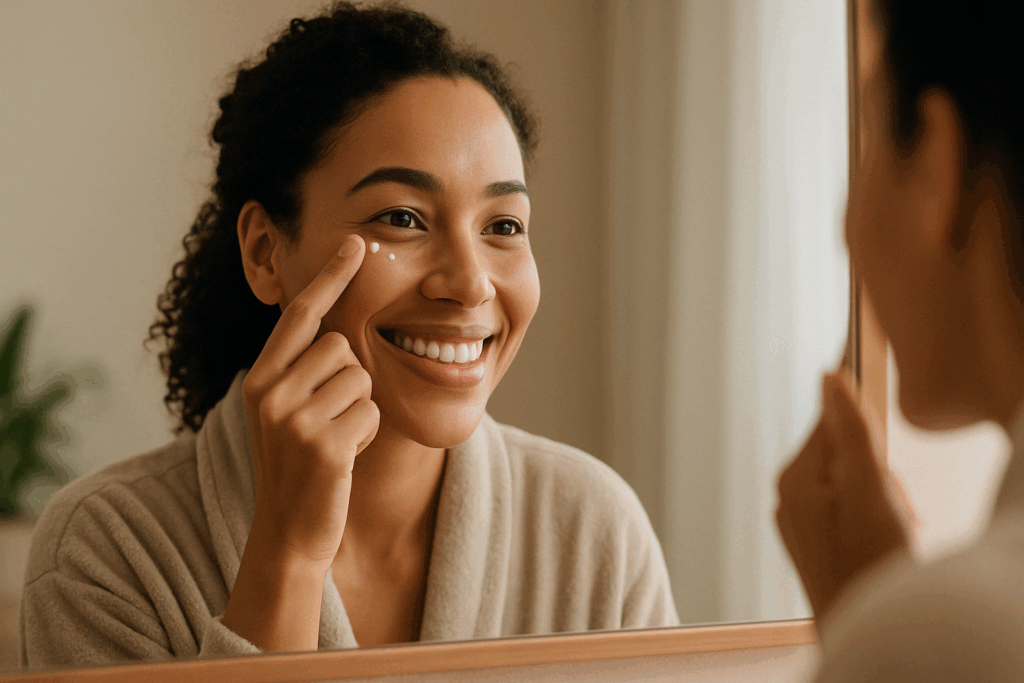The delicate area under the eyes is often the first to reveal signs of aging, fatigue, and stress. Puffiness, dark circles, fine lines, and sagging skin are common concerns that send many consumers searching for the perfect remedy. Among the most popular solutions are eye creams, marketed as targeted treatments to restore youthful vibrancy. But an increasingly common question arises: do eye creams work, or are they little more than well-packaged moisturizers with a hefty price tag? To answer this, it is essential to evaluate the science behind eye creams, their ingredients, mechanisms of action, and the dermatological consensus on their effectiveness.
You may also like: How to Choose Skin Care for Fine Lines: Evidence-Based Tips for Healthier, Younger-Looking Skin

Understanding the Skin Around the Eyes
The skin around the eyes differs significantly from that on other parts of the face. It is thinner, has fewer oil glands, and is more vulnerable to environmental stressors and repetitive movements, such as squinting or rubbing. These characteristics contribute to its increased susceptibility to dehydration, loss of elasticity, and the formation of fine lines. Additionally, the periorbital region lacks the fat and muscle support found in other facial areas, which can result in a hollow or sunken appearance over time. Because of these unique anatomical features, this region requires specific care strategies that address its specialized needs.
One of the arguments supporting the use of eye creams is that they are formulated with this anatomical difference in mind. Eye creams often claim to include smaller molecules for better absorption, lower concentrations of active ingredients to avoid irritation, and soothing agents tailored to this delicate area. However, the question remains: does eye cream work more effectively than a standard facial moisturizer when applied under the eyes, or is the distinction largely a matter of marketing?

Ingredient Efficacy: What Matters Most
To assess whether eye creams are truly effective, we must consider their ingredient profiles. Active ingredients commonly found in eye creams include peptides, hyaluronic acid, retinol, caffeine, niacinamide, and antioxidants like vitamin C and E. Each of these components serves a specific function in targeting under-eye concerns.
For instance, hyaluronic acid is renowned for its hydrating capabilities, binding water to the skin and creating a plumper, more youthful appearance. Retinol, a derivative of vitamin A, promotes cell turnover and collagen production but must be used cautiously around the eyes due to its potential to cause irritation. Peptides support collagen synthesis and may help reduce the appearance of fine lines over time. Caffeine is frequently included for its vasoconstrictive properties, temporarily reducing puffiness and the visibility of dark circles caused by dilated blood vessels.
Clinical research supports the efficacy of these ingredients in improving skin texture and firmness, particularly when used consistently over time. However, the concentration and formulation of these ingredients vary significantly between products. In evaluating whether or not eye creams work, one must also consider whether the product contains clinically significant concentrations of these actives and whether the formulation allows them to penetrate effectively into the skin.

Do Eye Creams Work Differently Than Regular Moisturizers?
One of the most contentious debates among dermatologists and skincare experts is whether eye creams provide a distinct benefit over traditional facial moisturizers. Critics argue that many eye creams are simply diluted versions of facial creams with a higher price point, offering no additional advantages. Proponents, on the other hand, suggest that their targeted design makes them more suitable for addressing periorbital concerns.
The truth likely lies somewhere in between. Some eye creams are formulated with advanced delivery systems or specialized actives that are well-suited for the thin skin around the eyes. These may include encapsulated retinol, gentle exfoliants, or innovative peptides. However, many over-the-counter options do not differ meaningfully in composition from standard moisturizers, apart from being fragrance-free or packaged in smaller containers. This raises the question for consumers: does eye cream work any better than a well-formulated facial cream when it comes to hydrating and protecting the under-eye area?
It is also worth noting that the placebo effect plays a significant role in skincare. Users who expect visible improvement may perceive positive changes even in the absence of measurable effects. Additionally, consistent application of any hydrating product may improve skin appearance through increased moisture retention, making it difficult to isolate the specific contribution of a specialized eye cream.

Addressing Specific Concerns: Dark Circles, Puffiness, and Wrinkles
One of the main marketing claims behind eye creams is their ability to combat dark circles, puffiness, and fine lines. These concerns have different physiological causes, which complicates the search for a one-size-fits-all solution. For example, dark circles may result from hyperpigmentation, vascular leakage, or shadowing from under-eye hollowness. Effective treatment thus depends on the underlying cause.
If dark circles are due to visible blood vessels or vascular congestion, ingredients like caffeine or vitamin K may offer temporary improvements. If pigmentation is the primary cause, then compounds like niacinamide, kojic acid, or licorice root extract may help lighten the area over time. For structural issues like fat loss or skin laxity, topical products have limited efficacy, and more invasive procedures, such as fillers, may be required to achieve noticeable changes.
Puffiness can be related to fluid retention, allergies, or aging-related fat displacement. Temporary relief may be achieved through cold compresses, elevation, or caffeine-containing eye creams. However, persistent puffiness from fat herniation or other anatomical changes may not respond well to topical treatment. Similarly, while certain peptides and retinoids can reduce fine lines with consistent use, they are unlikely to eliminate deeper wrinkles entirely. Therefore, the question “do eye creams work” must be answered with nuance: they can help manage minor issues and slow progression, but their effects are inherently limited by skin physiology and the aging process.

Scientific Evidence and Dermatological Consensus
A review of clinical literature reveals mixed results regarding the effectiveness of eye creams. Some studies demonstrate measurable improvements in skin hydration, texture, and pigmentation with specific formulations. For example, research published in peer-reviewed dermatology journals has shown that niacinamide and retinol-containing eye creams can significantly improve the appearance of wrinkles and pigmentation when used over several months. However, these improvements are generally modest and may not be visible to the naked eye in all users.
Other studies point to the role of consistent skincare routines—rather than individual product categories—in maintaining skin health. Dermatologists often emphasize that the most critical factors for eye-area maintenance include gentle cleansing, daily use of sunscreen, adequate hydration, and avoidance of excessive rubbing or tugging. From this perspective, whether or not an eye cream is used becomes less important than how the skin is treated overall.
That said, some dermatologists do advocate for the use of eye creams in specific circumstances. For individuals with sensitive skin, formulations free of fragrance and irritants may reduce the risk of dermatitis or inflammation. For aging individuals, a targeted eye product with proven actives may help delay the progression of fine lines and maintain a youthful appearance longer. These insights underscore that the effectiveness of eye creams is context-dependent and varies according to individual skin type, genetics, and lifestyle.
The Role of Lifestyle and Environmental Factors
No topical product can counteract the effects of chronic stress, inadequate sleep, poor nutrition, or unprotected sun exposure. These lifestyle factors have profound impacts on skin aging and overall appearance. Dark circles and puffiness, for example, are often exacerbated by fatigue, dehydration, and dietary sodium, which promote fluid retention. Similarly, prolonged sun exposure accelerates collagen breakdown, leading to premature wrinkling and skin laxity.
Because of this, dermatologists frequently recommend a holistic approach to skincare. In this model, eye creams are viewed as supportive tools rather than miracle cures. A person who maintains a consistent sleep schedule, eats antioxidant-rich foods, stays well-hydrated, and uses sunscreen daily is more likely to see benefits from any skincare regimen, including eye creams. Thus, when asking “does eye cream work,” it is essential to consider the broader context of one’s lifestyle habits.

Psychological and Emotional Impacts of Eye Appearance
In a culture where appearance is closely tied to perceptions of health, youth, and vitality, the condition of the under-eye area can significantly impact self-esteem and social confidence. For many, visible eye bags or dark circles are perceived as signs of aging or chronic fatigue, regardless of one’s actual health status. Eye creams, therefore, offer not only a physical benefit but also a psychological one, by giving users a sense of agency in managing their appearance.
This psychological component is not to be underestimated. Even minor improvements in skin tone or texture can boost a person’s self-perception, especially when those changes align with personal goals for aging gracefully or presenting a refreshed image. In this way, the question “do eye creams work” encompasses more than just molecular efficacy—it includes the broader emotional and social outcomes that influence how people feel in their own skin.
Cost, Marketing, and Consumer Expectations
One of the most significant barriers to evaluating eye cream efficacy is the marketing language used by cosmetic companies. Terms like “anti-aging,” “revitalizing,” and “clinically proven” are not always regulated with the same rigor as pharmaceutical claims. As a result, consumers may form inflated expectations about what these products can achieve. Price is another factor, with luxury eye creams often retailing for hundreds of dollars based on brand reputation rather than superior formulation.
Dermatologists and skin scientists often advise consumers to read ingredient labels critically and to focus on formulations backed by research, rather than packaging or price. Products containing known actives like retinol, peptides, and antioxidants are more likely to yield results than those relying on botanical extracts or vague proprietary blends. In this regard, eye creams that work are typically those that are transparent about their ingredients and supported by independent clinical studies.
Moreover, cost does not always correlate with efficacy. Some drugstore brands offer eye creams with well-researched ingredients at a fraction of the price of their luxury counterparts. The key difference lies in formulation stability, packaging (such as airless pumps versus open jars), and the integrity of the manufacturer. Ultimately, consumers should approach the eye cream market with a discerning eye, balancing scientific evidence with practical considerations.
Frequently Asked Questions: Do Eye Creams Work?
1. Can eye creams prevent aging if started early in adulthood?
Starting eye creams in your 20s or early 30s may help delay the appearance of aging signs, but it is not a foolproof method for prevention. While early use supports hydration and protects against environmental stressors, the aging process is influenced by genetics, lifestyle, and long-term sun exposure. The question “does eye cream work” in preventive skincare depends largely on product formulation and consistency of use. Products with antioxidants, peptides, and mild retinoids may help maintain skin elasticity and prevent fine lines from deepening over time. However, results will vary by individual, and no topical product can fully halt the intrinsic aging process.
2. Are natural or organic eye creams more effective than conventional ones?
Natural or organic eye creams appeal to those avoiding synthetic ingredients, but their effectiveness depends more on ingredient function than marketing labels. The debate over “do eye creams work” often ignores that organic formulations may lack the stability or clinical backing of conventional actives like retinol or peptides. While some natural ingredients such as green tea extract or aloe vera have mild anti-inflammatory benefits, they rarely deliver the same collagen-boosting effects as laboratory-tested compounds. Choosing a product based solely on its organic label does not guarantee efficacy, and consumers should examine ingredient concentration, not just origin. The most effective eye creams—natural or otherwise—are those supported by peer-reviewed evidence.
3. Can eye creams reduce the appearance of under-eye bags caused by lack of sleep?
Short-term puffiness resulting from fluid retention due to poor sleep may respond temporarily to eye creams containing caffeine or cold-application technologies. However, in cases where under-eye bags are chronic or structural, the answer to “does eye cream work” becomes more complex. While topical treatments can soothe inflammation and improve surface hydration, they cannot address anatomical fat herniation or genetic predispositions. In such cases, cosmetic procedures like fillers or blepharoplasty may be more appropriate. Eye creams offer symptom relief, not structural correction, making them a supportive—but not definitive—solution.
4. Is it necessary to use eye cream if I already use a rich moisturizer?
If your facial moisturizer contains effective ingredients and does not irritate your eye area, it may suffice for basic under-eye hydration. That said, asking “do eye creams work better than moisturizers” depends on your individual skin concerns. Eye creams are often formulated to be gentler, more concentrated, or free of irritants like fragrance and alcohol, which can make them preferable for sensitive skin. Moreover, they may include targeted ingredients in safer concentrations for delicate eye tissue. For people with specific issues like dark circles or fine lines, using a dedicated eye cream can offer more specialized support.
5. Do eye creams work better when applied with certain techniques or tools?
Application technique can influence how well an eye cream performs. Gently tapping the product into the skin using the ring finger minimizes pressure and prevents unnecessary tugging, which can accelerate wrinkling. Additionally, storing eye creams in a skincare fridge or using a chilled metal applicator may enhance the de-puffing effect of products with caffeine or green tea extract. When people ask “does eye cream work,” they often overlook how important correct and consistent application is to achieving results. Absorption is not only about formulation—it also depends on how you treat the skin during and after application.
6. Can eye creams cause irritation or worsen under-eye conditions?
Yes, especially when they contain potent actives like retinoids or alpha-hydroxy acids that are not adequately buffered or appropriately formulated for the eye area. For individuals with rosacea, eczema, or a compromised skin barrier, eye creams can sometimes trigger redness, itching, or dermatitis. In these cases, when people wonder “do eye creams work or do more harm,” the answer is conditional. Always patch-test a new product before full application and consult a dermatologist if you have a history of sensitivity. Choosing fragrance-free, hypoallergenic products with well-tolerated ingredients can reduce the risk of adverse reactions.
7. Are men likely to benefit from using eye creams, or are they primarily marketed toward women?
Although marketing often targets women, men can absolutely benefit from eye creams—particularly because under-eye issues like puffiness, dark circles, and fine lines are gender-neutral. The misconception that skincare is not masculine has prevented many men from exploring products that could improve their skin health and appearance. When considering whether “do eye creams work” for men, the answer is a clear yes, especially when the cream addresses specific concerns like stress-induced fatigue or sun damage. Men may gravitate toward lightweight gels or fast-absorbing creams that align with minimal grooming routines. Ultimately, efficacy is tied to ingredients and skin needs, not gender.
8. How do sleep positions affect the performance of eye creams?
The way you sleep can influence fluid retention and product absorption in the under-eye area. Sleeping face-down or on one side can contribute to fluid pooling and asymmetrical puffiness, potentially diminishing the perceived benefits of eye cream. When asking “does eye cream work as intended,” consider that even a well-formulated product may struggle to show results if sleep habits continually counteract its effects. Elevating your head with an extra pillow can reduce morning puffiness and improve the long-term results of your skincare routine. Skin regeneration also occurs during sleep, so pairing good habits with a nighttime eye cream can be particularly synergistic.
9. Are there technological advances making eye creams more effective today than in the past?
Yes, modern formulation technologies have significantly improved the delivery and stability of active ingredients. Encapsulation techniques allow for time-release delivery of retinoids or peptides, minimizing irritation while maximizing absorption. Additionally, advancements in biomimetic peptides and growth factors are expanding the scope of what eye creams can achieve. For consumers still wondering “do eye creams work” in an era of cosmetic innovation, the answer is increasingly affirmative—especially when using clinically backed, dermatologist-developed products. As science evolves, so too does the potential for eye creams to offer genuine, measurable results.
10. How should expectations be managed when starting a new eye cream?
Realistic expectations are crucial to evaluating whether or not an eye cream is working. Changes to skin texture, pigmentation, and elasticity often occur gradually over weeks or months, not overnight. Understanding this timeline can help prevent premature disappointment. The ongoing debate—”does eye cream work, or is it just hype?”—often stems from misunderstanding how long skin turnover and ingredient action actually take. Keeping a visual diary or taking photos every two weeks can provide a more accurate sense of progress. Patience and consistency are essential, and even modest improvements can be meaningful over time.
Conclusion: Do Eye Creams Work and Are They Worth It?
The answer to the question “do eye creams work” is multifaceted. Scientifically, many eye creams contain ingredients that can hydrate, brighten, and improve skin texture when used consistently. Dermatological evidence supports the modest benefits of formulations containing retinol, niacinamide, caffeine, peptides, and antioxidants—particularly when these are well-formulated and applied as part of a holistic skincare regimen. However, the degree of improvement varies widely based on individual skin type, age, genetics, and environmental exposures.
Eye creams are not miracle solutions, and they cannot reverse deep structural aging or eliminate all signs of fatigue. Yet they can serve as valuable components in a broader strategy for maintaining under-eye health. When paired with sun protection, proper sleep, hydration, and healthy lifestyle choices, a well-chosen eye cream can support both physical appearance and psychological well-being.
For consumers wondering “does eye cream work,” the most pragmatic approach is to view these products as supportive tools—not standalone solutions. The best outcomes occur when expectations are realistic, ingredients are chosen based on evidence, and usage is consistent over time. In this light, eye creams are not just cosmetic luxuries; they can be evidence-based enhancements to comprehensive skin health.
Was this article helpful? Don’t let it stop with you. Share it right now with someone who needs to see it—whether it’s a friend, a colleague, or your whole network. And if staying ahead on this topic matters to you, subscribe to this publication for the most up-to-date information. You’ll get the latest insights delivered straight to you—no searching, no missing out.
Further Reading:
A review of the efficacy of popular eye cream ingredients
Do Eye Creams Actually Work for Wrinkles?
The Benefits of Using an Eye Cream
Disclaimer
The information contained in this article is provided for general informational purposes only and is not intended to serve as medical, legal, or professional advice. While Health11News strives to present accurate, up-to-date, and reliable content, no warranty or guarantee, expressed or implied, is made regarding the completeness, accuracy, or adequacy of the information provided. Readers are strongly advised to seek the guidance of a qualified healthcare provider or other relevant professionals before acting on any information contained in this article. Health11News, its authors, editors, and contributors expressly disclaim any liability for any damages, losses, or consequences arising directly or indirectly from the use, interpretation, or reliance on any information presented herein. The views and opinions expressed in this article are those of the author(s) and do not necessarily reflect the official policies or positions of Health11News.